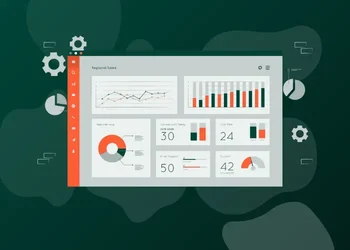HubSpot Marketing vs Non-Marketing Contacts | Differences Explained
Learn about the differences of HubSpot Marketing vs. Non-Marketing Contacts with our comprehensive guide.

Automate your marketing efforts with these marketing workflow examples that streamline tasks, improve lead nurturing, and enhance customer engagement.
It is in pure core nature that marketers would always try to find more stringent, quicker methods to achieve the best results possible. Achieving any of these goals is ascertained through the implementation of marketing workflows as one of the very effective and efficient approaches. The level of marketing automation depends upon the tool you have selected for your automation, during your CRM selection process make sure that you have considered all your requirements, it will help you choose a scalable CRM that will align with your needs.
What’s more, these workflows do not only help in automating, but also in streamlining, organizing, and perfecting the organization’s marketing activities. With the help of such well-developed workflows, an organization can improve on lead acquisition, customer engagement, and conversion all while wasting minimal resources such as time and money.
Marketing workflows can be defined as a series of cyclic actions that are initiated when something happens or when certain conditions are met. In a CRM system like HubSpot, you can perform a chain of activities aimed at the full customer lifecycle stages, from the generation of leads to their retention, and making sure that every action is done on time and with the slightest human effort.
For example, the moment one of the website visitors fills in a form for any purpose, the marketing workflow can trigger to send a welcome email, add this lead to a nurturing campaign, and even assign a sales officer to this particular lead. Such an approach to lead conversion enables quick progression and proper tracking of each record.
Automation is the new black. It affects every single sphere of marketing due to its efficiency, decreasing the amount of manual work required to be completed. Which not only creates new possibilities but also reduces the probability of human errors. However, there can be significant problems with marketing automation, such as misaligned campaigns or data discrepancies, if not carefully managed.
Marketing automation performs deeds that used to be done repeatedly, allowing marketers to perform more creative work, such as building engaging content or evaluating the efficiency of the trained campaigns.
Also, marketing automation makes it possible to make data-driven decisions. When you have customer data and track their behavior as well as their interactions with them, you can improve your marketing strategies by changing how you target your audience. People gain interest in such messages, buy more, and finally, the organization gets more returns on the investments.
-png.png?width=680&height=383&name=Marketing%20Workflows%20(1)-png.png)
Marketing workflows offer several advantages that make the operations of your business better rated:
Here are some of the main marked perks:
Automating decreases the potential of doing monotonous and routine tasks enhancing the potential of focusing on more critical and wider-band strategy issues.
Workflows are settled as the means of text control over most if not all channels hence enhancing the text-to-audience approach.
The automated systems ensure that follow-ups are done in time and that leads and customers are developed further in their period.
It enables scheduling using the workflows and then following up on the appropriate actions for the optimum output of the marketing plan.
We’ll take a closer look at 14 marketing workflow examples you can use to boost your marketing efforts with a laser-sharp focus on efficiency.
A lead capture workflow is designed to manage leads as they enter your system and automatically:
Send a thank-you email to the lead.
Notify your sales team of the new lead.
Assign the lead to a specific marketing campaign based on their interests.
It makes sure that every lead is picked up right away and kept on track, increasing the chances that it’ll become a customer.

Every business with an online presence should have several workflows set up to guide leads along the sales funnel. This specific lead nurturing workflow should:
Send targeted emails based on the lead’s interactions with your content.
Provide relevant resources to address the lead’s pain points.
Move to the next step in the sales process when they qualify for it.
As you nurture these leads on a more personal level with targeted content, your chance of success increases.

First impressions are important, and a new contact welcome workflow allows you to make a good one. Whenever a new contact is added to your database, this workflow will:
Send a welcome email introducing your brand.
Provide an overview of your products or services.
Offer a special discount or resource to encourage engagement.
This workflow helps onboard new contacts and sets the stage for a fruitful relationship.

Usually content downloads, be it ebooks or whitepapers, act as effective lead magnets. The content download workflow helps nurture such leads effectively by:
Follow-up sending with the email with the download link.
Giving other related content to the user.
Offering the user the ability to register for a webinar or to get a consultation based on their interests.
This workflow ensures that the lead doesn’t get lost in the system and further connectivity with the brand is encouraged.

Abandoned cart workflows are always one of the important workflows for e-commerce businesses. This workflow also enables you to recoup the lost sales opportunities by:
Sending an email reminder to the customer who left items in their cart.
Promising some kind of discount or any motivation to the customer to complete the order.
Making up suggestions to the customer about the items they put aside.
Indeed, this is a great way to promote the customers as it brings them back and increases your conversion rates.

As time goes on, some leads or customers might go quiet. A re-engagement workflow tends to reintroduce them in the process by:
The first and foremost methodology of this is sending a series of re-engagement emails with persuasive offers.
Request feedback to know what made them inactive in the first place.
Providing recommendations or even special offers.
This activity helps in returning customers' interest and may also bring back some clients with garnered love for the business.

Managing and coordinating event registration takes a long period, but even event registration workflow can eliminate the difficulties by:
Emails are sent to the registrant who has confirmed their registration.
Reminders and event information in the days leading up to the west.
Following the event, changes would be made to additional emails sent to prospects whereby no follow-ups regarding the prospects were made.
This workflow guarantees that the registration stage is efficient and that active persons who will participate are excited.

Webinars are powerful tools for lead generation, and a webinar follow-up workflow can maximize their impact by:
Sending a thank-you email to attendees.
Sharing the webinar recording and any related materials.
Encouraging further engagement, such as booking a demo or consultation.
By staying in touch with webinar attendees, you can continue to nurture these leads toward a conversion.

Understanding customer feedback is crucial for improving your products or services. A customer feedback workflow can help by:
Sending automated surveys after a purchase or interaction.
Collecting and organizing feedback for analysis.
Following up with customers who provided feedback, thanking them, and addressing any issues.
This workflow allows you to gather valuable insights and demonstrate that you value your customers' opinions.

Maximizing the value of existing customers is key to growing your business. A cross-sell/up-sell workflow can help by:
Identifying opportunities to offer complementary products or services.
Sending targeted emails with personalized recommendations.
Providing incentives for customers to make additional purchases.
This workflow increases customer lifetime value and enhances overall revenue.

For businesses with subscription models or contracts, a customer renewal workflow is essential. This workflow can:
Send reminders to customers as their renewal date approaches.
Offer incentives for early renewal or upgrades.
Automate the renewal process to ensure continuous service.
By proactively managing renewals, this workflow helps maintain steady revenue and customer satisfaction.

Personalization goes a long way in building customer loyalty. A birthday/anniversary workflow can:
Send personalized messages or offers on special occasions.
Offer discounts or gifts to celebrate.
Strengthen the emotional connection with your brand.
This workflow makes customers feel valued and appreciated, fostering long-term loyalty.

Keeping your email list engaged is critical for the success of your email marketing efforts. An email engagement workflow can:
Segment your audience based on their interaction with your emails.
Send re-engagement campaigns to those who haven’t opened your emails in a while.
Optimize email content and timing to boost engagement rates.
By maintaining high levels of engagement, this workflow ensures your email campaigns remain effective.

For businesses offering free trials, converting trial users into paying customers is crucial. A free trial workflow can:
Engage with users throughout the trial period with tips and resources.
Send reminders as the trial period ends, encouraging users to subscribe.
Offer incentives for converting to a paid plan.
By nurturing trial users, this workflow increases the likelihood of conversion and long-term customer retention.

Marketing workflows are powerful tools that can transform the way you manage and execute your marketing efforts. By automating repetitive tasks, ensuring consistency in messaging, and enabling data-driven decision-making, workflows help you achieve optimal efficiency and effectiveness in your campaigns.
.png?format=webp&width=400&height=250&name=HubSpot%20Marketing%20vs%20Non-Marketing%20Contacts%20(1).png)
Learn about the differences of HubSpot Marketing vs. Non-Marketing Contacts with our comprehensive guide.

Explore the top 7 HubSpot marketing dashboards to streamline your marketing strategy, enhance ROI, and make data-driven decisions with custom...

Differentiate between Account-Based Marketing (ABM) and Marketing Automation to enhance your marketing endeavors effectively.